‘Do post-playing careers affect our view of Hockey Hall of Fame cases?’ Featuring Rod Brind’Amour
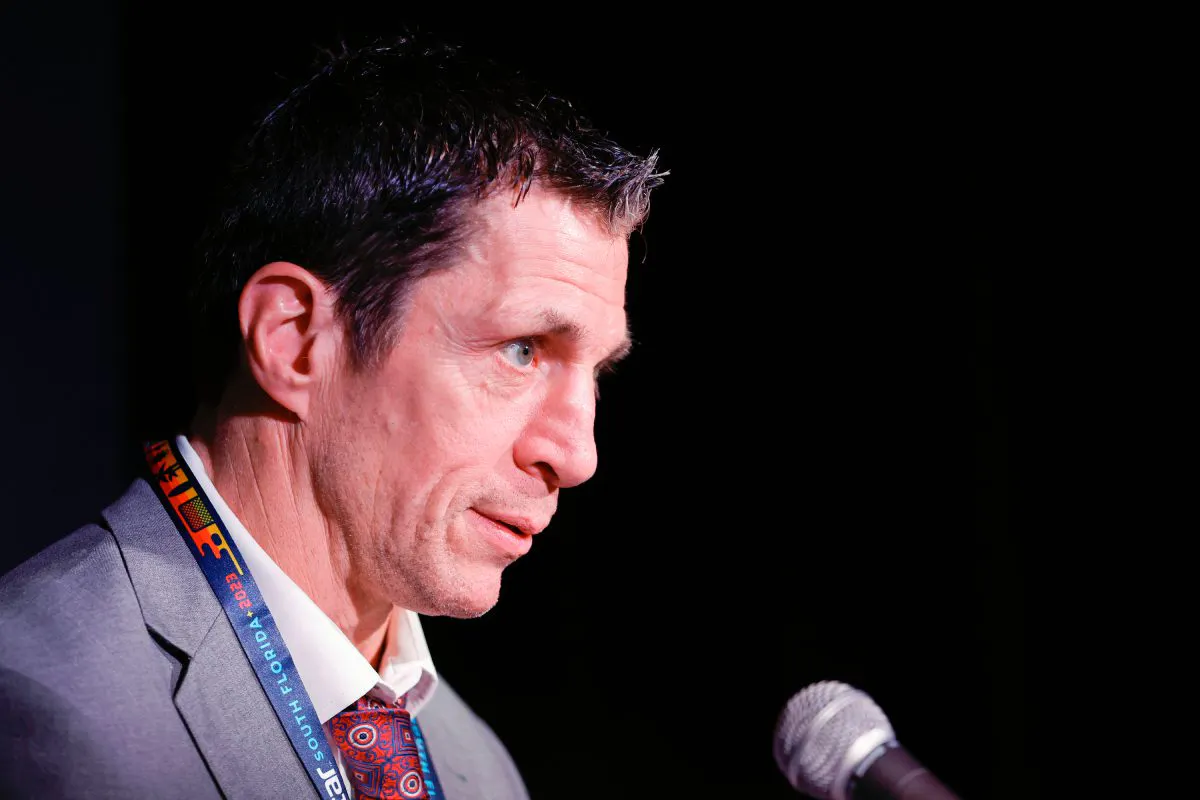
On the lead up to the Hockey Hall of Fame’s announcement of the 2023 Class on Wednesday, June 21, we’ll be profiling eight hopeful candidates. Each player profile will help answer a hard-hitting question about the HHOF and what membership to the game’s most exclusive honor should look like.
A man in a dark suit sits in front of a microphone, calmly taking questions from reporters. He won’t be confused with a politician or a school principal. His chiseled physique stands out. His face shows the marks of a past life. His piercing eyes bore a hole through your soul. The replies at this press conference are sincere and to the point, absent the slightest rhetoric.
One thing is clear… this man is the coolest person in the room.
Rod Brind’Amour is reluctantly holding court after his Carolina Hurricanes methodically thrashed the New Jersey Devils 6-1 in Game 4 of their Eastern Conference playoff series. While he hasn’t suited up for an NHL game in 13 years, his legend grows by the game, series, and season. This leads us to today’s Hockey Hall of Fame question — does a former player’s public life in retirement change how we view their playing career?
The Narratives 🎙️
- Big Proponent: “With two Selke Trophies and the fifth-most points of any player awaiting induction, ‘Rod the Bod’ is a Cup-winning captain and relentless force worthy of the sport’s highest respect.”
- Big Opponent: “A reliable second-line center that compiled totals across a long career, Brind’Amour is a celebrated coach but was never a top-tier NHL player.”
The Stats 💻
- NHL Career (1989-2010): 20 seasons — St. Louis, Philadelphia, Carolina

The High Noon Card 🕛
High Noon rankings are the equivalent of the world golf or tennis rankings — only for hockey. A player’s High Noon answers the question: “Where did they rank at their best in the NHL at their position?”
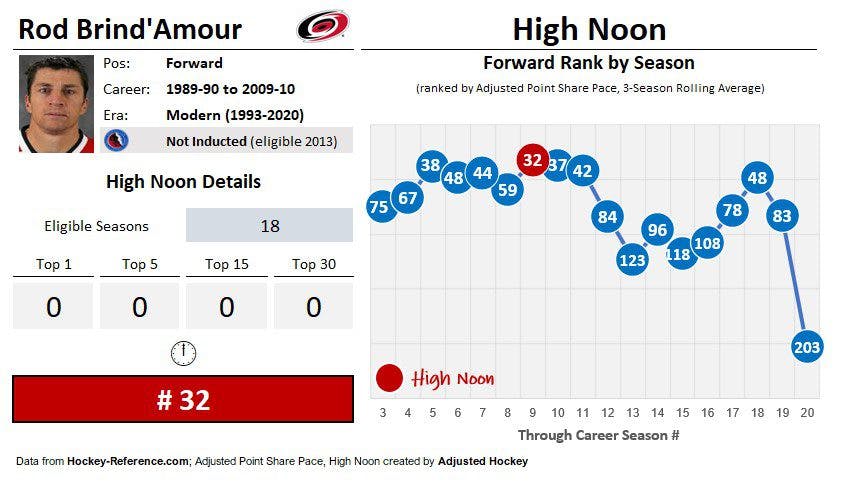
Brind’Amour’s enduring career belongs in a time capsule of NHL evolution. Debuting at age 19 in St. Louis, he’d retire in Carolina nearing his 40th birthday. In between his 1,643 regular season and playoff games? Nine expansion teams, two lockouts, a 22% drop in NHL scoring, a surge in player salaries, and a salary cap.
Longevity aside, how did Brind’Amour rank league-wide at his best?
In High Noon, he peaks as the NHL’s 32nd-best forward. From a HHOF perspective, this is a gut punch. Or in Brind’Amour’s case, a punch to his rock hard core that sprains your wrist. Of the 61 post-expansion NHL forwards inducted, only two players peak lower — all-time defensive specialists Bob Gainey (#111) and Guy Carbonneau (#82). No other HHOF forward has a High Noon below #16. Some place Brind’Amour in this upper echelon of defensive artists, an avenue we’ll soon explore.
Even if you’re a card-carrying member of Team Rod, however, it’s difficult to argue that reputationally he was among the best at any one point. Statistically, it’s not possible.
The PPS Card 📊
The Pidutti Point Share (PPS) system measures a player’s HHOF worthiness in a single comprehensive number. A player’s PPS score is tiered based on the HHOF standard for their position and era.
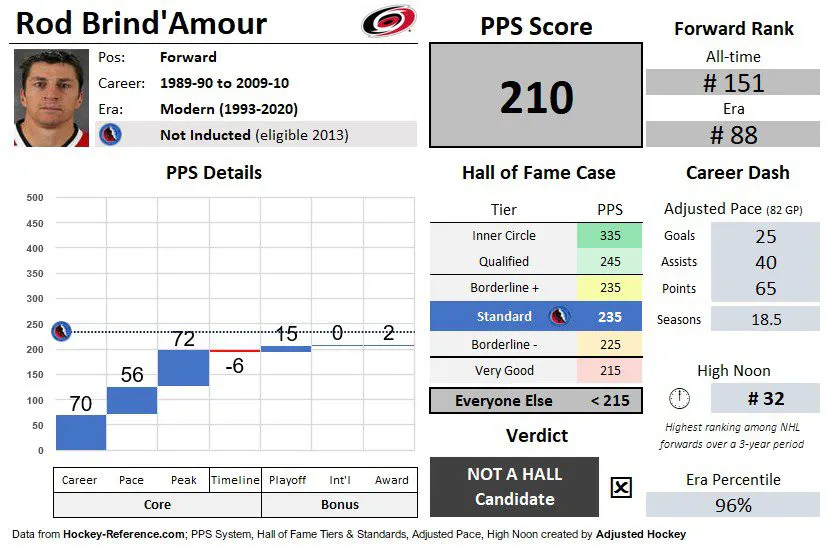
Brind’Amour’s PPS of 210 is short of the modern HHOF forward standard (235). It’s possible this understates his contributions given the limits of defensive data. It’s an uphill climb to get Brind’Amour to be considered the next-best choice though — there are a whopping 33 eligible forwards ahead of him.
His Career score (70) is a respectable mark, tied for 39th among the 61 elected post-expansion forwards. Playing so long comes at the cost of efficiency. Only four of the 61 HHOF forwards rank below Rod in Pace score (56), suggesting he banked career value without sustaining a consistently high level of play. As for his Peak score (72), Brind’Amour’s best seven-season stretch is unflattering historically. The average HHOF forward scores a 99 in Peak. His Peak would be fifth from the bottom, wedged between Bernie Federko (74) and Clark Gillies (66).
When it comes to the post-season, Brind’Amour gets a healthy 15-point bonus (maximum 30). This is the result of his contributions to a Stanley Cup (+10), plus a bump (+5) from reaching five conference finals, three Cup finals, and a playoff-leading 13 goals in Philadelphia in 1997. Internationally, Canada has lost only four of 14 best-on-best events, but Brind’Amour experienced it twice — the ’96 World Cup loss to U.S.A. and the humbling ’98 Nagano Olympics. While the selections are a compliment, his international bonus is nil.
For award bonuses, Brind’Amour did not factor into MVP races, earning votes just once (10th place). His back-to-back Selkes earn him a +2 bonus.
The Selkes, finally.
You might be thinking this is all that should matter. A total badass captain that banked a ton of points, armed with two Selkes on his mantle… elect this man! Let’s check the all-time Selke voting share leaders, offering the truest sense of the award’s history.
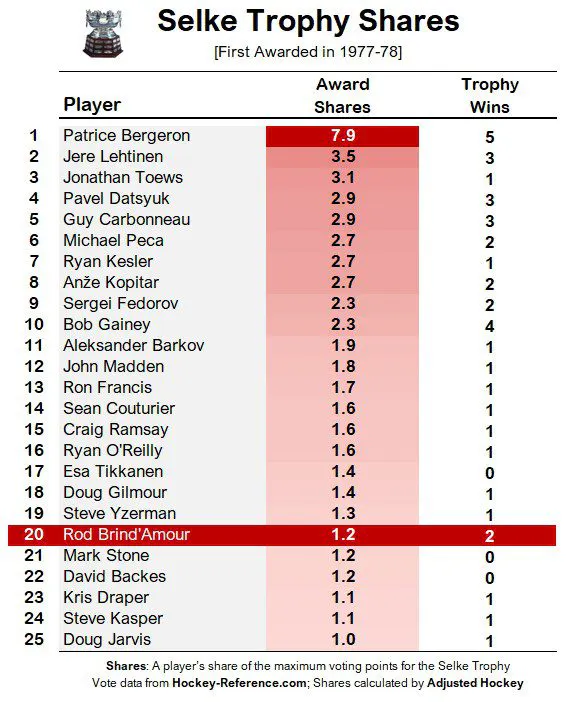
Perhaps the most controversial part of Brind’Amour’s legacy is his standing as an all-world defensive maestro. In his first 15 NHL seasons, he did not receive a single vote on 10 occasions, with finishes of 16th, 13th, 9th, 17th and 49th his only mentions. To that point — which covers 75% of his career — he’d received 0.12 Selke shares, which would rank 106th all-time.
In the twilight of his career, his defensive reputation exploded. While memories of the Cup champion 2005-06 Hurricanes may be foggy, the team was an offensive powerhouse — third in goals scored, sixth in shots. Defensively? It was an uninspired outfit. 18th in goals against. 19th in shots against. 19th on the penalty kill.
Yet in 2005-06, Brind’Amour won his first of consecutive Selkes in a landslide, gobbling up 77% of the vote. Make no mistake: at age 35, he was a physical marvel. He averaged 24:18 of ice time. He took 2,145 faceoffs, still the most all-time. He won 59.1% of those draws, third in the NHL. Incredible feats at any age, and mind-blowing at 35. But ice time and faceoffs have long since proven to be red herrings when it comes to defensive credentials. As a result, the idea of the media becoming obsessed with an aging warrior that never leaves the ice and dominates the faceoff circle creeps into the conversation.
Numbers aside, Brind’Amour was not Gainey or Carbonneau by reputation. In fact, each of the eight multiple Selke winners had at least five top-five finishes for the award. Brind’Amour’s two wins in his mid-30s were the only times he was ever considered. If he’s to be labeled one of the game’s all-time best defensively, it’s at least curious his next-best showing was 9th place.
The Comparisons 🧬
Who a player profiles most similarly to statistically is revealing as it removes any influence from reputation or playing style. Using career length, adjusted scoring, and the core factors of PPS, a player’s top five matches are presented. 1,000 is a perfect match.

While no one can compare to Rod’s bod, let’s have a look at who compares to him statistically. The group boasts five incredible résumés but would be fairly described as fringe HHOF candidates. By PPS, Staal (227) is nearest the standard of 235.
The bad news? Staal is by far the best of the quintet. The four forwards that match closest to Brind’Amour rank in the low end of the Hall of Very Good tier (215 to 225) and below. It’s a collection of steady scoring threats with one Stanley Cup across long careers, absent particularly memorable primes. None of the four have any notable public HHOF momentum.
The Answer ⚖️
Do post-playing careers affect our view of Hockey Hall of Fame cases?
Using PPS as our star witness, we can objectively assess recent inductees to help answer the question. Going back five cycles, we’ll identify NHL inductees below the standard and elected after long waits. From here, we can gauge whether their post-playing life impacted their selection.
- Kevin Lowe (2020): An out-of-nowhere choice, Lowe spent around two decades with the Oilers as a coach, GM, and executive. He also had a hand in managing two Canadian Olympic gold medal winners and a World Cup champion.
- Doug Wilson (2020): Decimal points below the standard, Wilson was retired for 27 years before the HHOF called. In retirement, he’s been a respected executive in San Jose for a quarter century, rising to GM of the perennially-competitive Sharks.
- Guy Carbonneau (2019): Immediately after retiring, Carbo jumped straight into coaching. By 2006, he was head coach of hockey’s most iconic franchise in Montreal.
These three recent holdover selections gained notoriety in retirement. Each held prominent roles in hockey for at least a decade. Like Brind’Amour, the trio added credibility as admired hockey lifers, occupying significant limelight far beyond their last shift. While we can’t know for sure, the evidence suggests their relevance in retirement elevated long-lost HHOF cases.
The Verdict 🚦
Brind’Amour’s case is summed up as follows: beloved dude (check!), solid offensively (check!) and, most importantly, one of the best ever defensively (questionable). During and immediately after his playing days, Brind’Amour’s candidacy was fairly muted. His HHOF momentum is a newer development, picking up steam as his aura grows in real time.
So, while he’s first ballot Hall of Awesome, his coaching prowess and media action give him daily Ultimate Warrior and Cool Coach energy in the public eye. As a result, his excellent playing career has been retroactively lionized into something far greater.
Labeling a player just outside the upper 1.5% of forwards is far from criticism, even if it often feels that way. After a deep dive, it’s challenging to find Brind’Amour’s path as a Player, which the HHOF by-laws separate as a distinct category from Builders. Unless the Selection Committee blurs its rules and factors in his thriving coaching career, his induction would suggest a case of revisionist history.
If Brind’Amour is elected, it will be a celebration of a man that represents all that’s good about hockey. But forgive me Rod fans, the on-ice case is light.
Catch up on the series:
- Should six outstanding seasons get a player into the Hockey Hall of Fame?’ Featuring John LeClair
Adjusted Pace, High Noon, PPS System, High Noon & PPS Player Cards, Player Comparison Tool from Adjusted Hockey; All other data from Hockey-Reference.com
_____
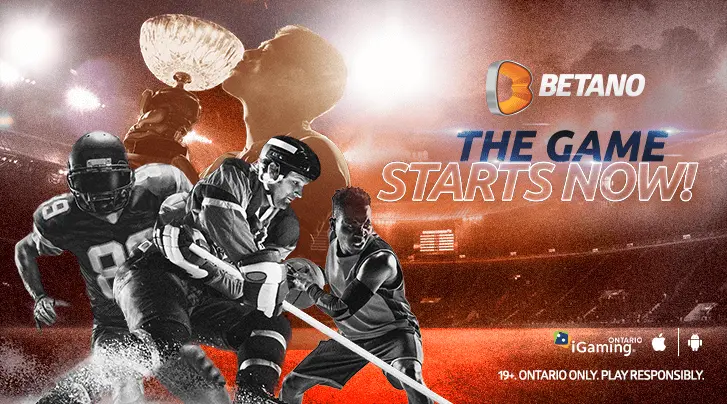
Discover Betano.ca – a premium Sports Betting and Online Casino experience. Offering numerous unique and dynamic betting options along with diverse digital and live casino games, Betano is where The Game Starts Now. 19+. Please play responsibly.